An Empirical Analysis of Driving Factors and Policy Enablers of Heritage Adaptive Reuse within the Circular Economy Framework
Abstract
1. Introduction
1.1. Scope and Aim of This Study
1.2. PESTEL-CA Framework
2. Materials and Methods
2.1. Semi-Systematic Literature Review and Thematic Analysis
2.2. Survey on Policy Enablers and Statistical Analysis
3. Results
3.1. Driving Factors and Policy-Related Instruments for Adaptive Reuse
3.2. Identification of Multi-Level Policy Enablers
3.3. Assessment of Policy Enablers for Adaptive Reuse
3.3.1. Assessment of European Policy Enablers
3.3.2. Assessment of National Policy Enablers
3.3.3. Assessment of Local Policy Enablers
4. Discussion and Conclusions
Author Contributions
Funding
Institutional Review Board Statement
Informed Consent Statement
Data Availability Statement
Acknowledgments
Conflicts of Interest
References
- Foster, G.; Kreinin, H. A review of environmental impact indicators of cultural heritage buildings: A circular economy perspective. Environ. Res. Lett. 2020, 15, 043003. [Google Scholar] [CrossRef]
- Gravagnuolo, A.; Fusco Girard, L.; Ost, C.; Saleh, R. Evaluation criteria for a circular adaptive reuse of cultural heritage. BDC Boll. Del Cent. Calza Bini 2017, 17, 185–216. [Google Scholar]
- Foster, G. Circular economy strategies for adaptive reuse of cultural heritage buildings to reduce environmental impacts. Resour. Conserv. Recycl. 2020, 152, 104507. [Google Scholar] [CrossRef]
- Ball, R. Developers, regeneration and sustainability issues in the reuse of vacant buildings. Build. Res. Inf. 1999, 27, 140–148. [Google Scholar] [CrossRef]
- Kurul, E. A qualitative approach to exploring adaptive reuse processes. Facilities 2007, 25, 554–570. [Google Scholar] [CrossRef]
- Wilkinson, S.; Reed, R.; Kimberley, J. Using building adaptive reuse to deliver sustainability in Australia. Struct. Surv. 2009, 27, 46–61. [Google Scholar] [CrossRef]
- Bullen, P.; Love, P. Factors influencing the adaptive re-use of buildings. J. Eng. Des. Technol. 2011, 9, 32–46. [Google Scholar] [CrossRef]
- Conejos, S.; Langston, C.; Chan, E.H.W.; Chew, M.Y.L. Governance of heritage buildings: Australian regulatory barriers to adaptive reuse. Build. Res. Inf. 2016, 44, 507–519. [Google Scholar] [CrossRef]
- Fusco Girard, L.; Gravagnuolo, A. Circular economy and cultural heritage/landscape regeneration. Circular business, financing and governance models for a competitive Europe. BDC Boll. Del Cent. Calza Bini 2017, 1, 35–52. [Google Scholar]
- Shahi, S.; Esfahani, M.E.; Bachmann, C.; Haas, C. A definition framework for building adaptation projects. Sustain. Cities Soc. 2020, 63, 102345. [Google Scholar] [CrossRef] [PubMed]
- Fusco Girard, L. Implementing the circular economy: The role of cultural heritage as the entry point. Which evaluation approaches? BDC Boll. Del Cent. Calza Bini 2019, 9, 245–277. [Google Scholar]
- Australia ICOMOS. The Burra Charter: The Australia ICOMOS Charter for Places of Cultural Significance; ICOMOS: Sydney, Australia, 2013. [Google Scholar]
- Europa Nostra. Leeuwarden Declaration: Adaptive Re-Use of the Built Heritage—Preserving and Enhancing the Values of our Built Heritage for Future Generations; Europa Nostra: Hague, The Netherlands, 2018. [Google Scholar]
- European Commission. Renovation Wave: The European Green Deal; EC: Brussels, Belgium, 2020. [Google Scholar]
- Leising, E.; Quist, J.; Bocken, N. Circular economy in the building sector: Three cases and a collaboration tool. J. Clean. Prod. 2018, 176, 976–989. [Google Scholar] [CrossRef]
- Gravagnuolo, A.; De Angelis, R.; Iodice, S. Circular Economy Strategies in the Historic Built Environment: Cultural Heritage Adaptive Reuse. In Proceedings of the STS Conference, Graz, Austria, 6–7 May 2019. [Google Scholar]
- Fusco Girard, L.; Nocca, F. Moving towards the circular economy/city model: Which tools for operationalizing the model? Sustainability 2019, 11, 6253. [Google Scholar] [CrossRef]
- Ikiz Kaya, D.; Dane, G.; Pintossi, N. Subjective circularity performance analysis of adaptive heritage reuse practices in the Netherlands. Sustain. Cities Soc. 2021. under review. [Google Scholar]
- Ikiz Kaya, D.; Pintossi, N.; Koot, C.A.M.; Colenbrander, B. CLIC Deliverable 1.5: Report on Barriers and Bottlenecks. 2019. Available online: https://www.clicproject.eu/files/D1-5.pdf (accessed on 29 November 2020).
- Kapsalis, V.C.; Kyriakopoulos, G.; Aravossis, K.G. Investigation of ecosystem services and circular economy interactions under an inter-organizational framework. Energies 2019, 12, 1734. [Google Scholar] [CrossRef]
- Allegro, I.; Lupu, A. Models of public private partnership and financial tools for the cultural heritage valorisation. Urban. Inf. 2019, 4, 1–10. [Google Scholar]
- Leadbeter, P. Adaptive reuse of heritage buildings—Do the current planning and heritage controls support the concept? Environ. Plan. Law J. 2013, 30, 491–507. [Google Scholar]
- Shipley, R.; Utz, S.; Parsons, M. Does adaptive reuse pay? A study of the business of building renovation in Ontario, Canada. Int. J. Herit. Stud. 2006, 12, 505–520. [Google Scholar] [CrossRef]
- Tam, V.W.Y.; Hao, J.J.L. Adaptive reuse in sustainable development. Int. J. Constr. Manag. 2019, 19, 509–521. [Google Scholar] [CrossRef]
- Throsby, D. Investment in urban heritage conservation in developing countries: Concepts, methods and data. City Cult. Soc. 2016, 7, 81–86. [Google Scholar] [CrossRef]
- Aravossis, K.G.; Kapsalis, V.C.; Kyriakopoulos, G.L.; Xouleis, T.G. Development of a holistic assessment framework for industrial organizations. Sustainability 2019, 11, 3946. [Google Scholar] [CrossRef]
- Kyriakopoulos, G.L.; Kapsalis, V.C.; Aravossis, K.G.; Zamparas, M.; Mitsikas, A. Evaluating circular economy under a multi-parametric approach: A technological review. Sustainability 2019, 11, 6139. [Google Scholar] [CrossRef]
- Oxford College of Marketing. What Is a PESTEL Analysis? Oxford University Press: Oxford, UK, 2016. [Google Scholar]
- Witcher, B.J.; Chau, V.S. Strategic Management Principles and Practice; Cengage Learning EMEA: Liverpool, UK, 2010. [Google Scholar]
- Gravagnuolo, A.; Angrisano, M.; Fusco Girard, L. Circular economy strategies in eight historic port cities: Criteria and indicators towards a circular city assessment framework. Sustainability 2019, 11, 3512. [Google Scholar] [CrossRef]
- Issa, D.T.; Chang, A.V. Sustainable business strategies and PESTEL framework. GSTF Int. J. Comput. 2011, 1, 1–8. [Google Scholar]
- Verhoef, E.T.; Nijkamp, P. Spatial externalities and the urban economy. In Urban Dynamics and Growth: Advances in Urban Economics; Elsevier: Amsterdam, The Netherlands, 2004; pp. 87–120. [Google Scholar]
- Lami, I.M.; Mecca, B. Assessing social sustainability for achieving sustainable architecture. Sustainability 2021, 13, 142. [Google Scholar] [CrossRef]
- Santi, G.; Leporelli, E.; Di Sivo, M. Improving sustainability in architectural research: Biopsychosocial requirements in the design of urban spaces. Sustainability 2019, 11, 1585. [Google Scholar] [CrossRef]
- Polese, M.; Stren, R.E. The Social Sustainability of Cities: Diversity and the Management of Change; University of Toronto Press: Toronto, ON, Canada, 2000. [Google Scholar]
- Colantonio, A. Urban social sustainability themes and assessment methods. Urban Design Plan. 2010, 163, 79–88. [Google Scholar] [CrossRef]
- Blagojevic, M.R.; Tufegdzic, A. The new technology era requirements and sustainable approach to industrial heritage renewal. Energy Build. 2016, 115, 148–153. [Google Scholar] [CrossRef]
- Guzman, P.C.; Pereira Roders, A.; Colenbrander, B.J.F. Measuring links between cultural heritage management and sustainable urban development: An overview of global monitoring tools. Cities 2017, 60, 192–201. [Google Scholar] [CrossRef]
- United Nations Educational Scientific and Cultural Organisation (UNESCO). UNESCO’s Work on Culture and Sustainable Development: An Evaluation of a Policy Theme; UNESCO: Paris, France, 2015. [Google Scholar]
- International Bureau of Education UNESCO—Concept of Governance. Available online: http://www.ibe.unesco.org/en/geqaf/technical-notes/concept-governance#:~:text=Governance%20has%20been%20defined%20to,%2C%20and%20broad%2Dbased%20participation. (accessed on 20 January 2020).
- Rihoux, B.; Grimm, H. Beyond the ‘qualitative-quantitative’ divide: Innovative comparative methods for policy analysis. In Innovative Comparative Methods for Policy Analysis: Beyond the Quantitative-Qualitative Divide; Rihoux, B., Grimm, H., Eds.; Springer: New York, NY, USA, 2006; pp. 1–9. [Google Scholar]
- Ward, V.; House, A.; Hamer, S. Developing a framework for transferring knowledge into action: A thematic analysis of the literature. J. Health Serv. Res. Policy 2009, 14, 156–164. [Google Scholar] [CrossRef] [PubMed]
- Synder, H. Literature review as a research methodology: An overview and guidelines. J. Bus. Res. 2019, 104, 333–339. [Google Scholar] [CrossRef]
- Wohlin, C. Guidelines for Snowballing in Systematic Literature Studies and a Replication in Software Engineering. In Proceedings of the 18th International Conference on Evaluation and Assessment in Software Engineering; ACM: London, UK, 2014; pp. 1–10. [Google Scholar]
- Clarke, V.; Braun, V.; Terry, G.; Hayfield, N. Thematic analysis. In Handbook of Research Methods in Health and Social Sciences; Liamputtong, P., Ed.; Springer: Singapore, 2019; pp. 843–860. [Google Scholar]
- Schöpfel, J. Towards a prague definition of grey literature. In Proceedings of the Twelfth International Conference on Grey Literature: Transparency in Grey Literature, Prague, Czech Republic, 6–7 December 2010; pp. 11–26. [Google Scholar]
- Veldpaus, L.; Fava, F.; Brodowicz, D. Mapping of Current Heritage Re-Use Policies and Regulations in Europe: Complex Policy Overview of Adaptive Heritage Re-Use. 2019. Available online: https://ec.europa.eu/futurium/en/system/files/ged/d_1.2_mapping_of_current_heritage_re-use_policies_and_regulations_in_europe.pdf (accessed on 18 October 2020).
- Tongco, D.C. Purposive sampling as a tool for informant selection. Ethnobot. Res. Appl. 2007, 5, 147–158. [Google Scholar] [CrossRef]
- CLIC EU H2020 Project. Available online: https://www.clicproject.eu/ (accessed on 17 November 2020).
- Abastante, F.; Lami, I.M.; Mecca, B. How to revitalise a historic district: A stakeholders-oriented assessment framework of adaptive reuse. In Values and Functions for Future Cities; Mondini, G., Oppio, A., Stanghellini, S., Bottero, M., Abastante, F., Eds.; Springer: Cham, Switzerland, 2020; pp. 3–20. [Google Scholar]
- Vecchio, M.; Arku, G. Promoting adaptive reuse in Ontario: A planning policy tool for making the best of manufacturing decline. Urban Plan. 2020, 15. [Google Scholar] [CrossRef]
- Torrieri, F.; Fumo, M.; Sarnataro, M.; Ausiello, G. An integrated decision support system for the sustainable reuse of the former monastery of “Ritiro del Carmine” in Campania region. Sustainability 2019, 11, 5244. [Google Scholar] [CrossRef]
- Remoy, H.; van der Voordt, T. Adaptive reuse of office buildings into housing: Opportunities and risks. Build. Res. Inf. 2014, 42, 381–390. [Google Scholar] [CrossRef]
- Kohler, N.; Yang, W. Long-term management of building stocks. Build. Res. Inf. 2007, 35, 351–362. [Google Scholar] [CrossRef]
- Zhang, Y.; Kang, S.; Koo, J.H. What is the critical factor and relationship of urban regeneration in a historic district? A case of the Nanluoguxiang area in Beijing, China. Sustainability 2019, 11, 6772. [Google Scholar] [CrossRef]
- Muminović, E.; Radosavljević, U.; Beganović, D. Strategic planning and management model for the regeneration of historic urban landscapes: The case of historic center of Novi Pazar in Serbia. Sustainability 2020, 12, 1323. [Google Scholar] [CrossRef]
- Ellison, L.; Sayce, S.; Smith, J. Socially responsible property investment: Quantifying the relationship between sustainability and investment property worth. J. Prop. Res. 2007, 24, 191–219. [Google Scholar] [CrossRef]
- Tanrikul, A.; Hoşkara, S. A new framework for the regeneration process of Mediterranean historic city centres. Sustainability 2019, 11, 4483. [Google Scholar] [CrossRef]
- Pickard, R.; Pickerill, T. Conservation finance 2: Area-based initiatives and the role of foundations, funds and non-profit agencies. Struct. Surv. 2002, 20, 112–116. [Google Scholar] [CrossRef]
- Della Spina, L. Adaptive sustainable reuse for cultural heritage: A multiple criteria decision aiding approach supporting urban development processes. Sustainability 2020, 12, 1363. [Google Scholar] [CrossRef]
- Morandotti, M.; Besana, D.; Cecchini, C.; Chiesa, A. A decision-making process for resilience assessment in adaptive reuse. IOP Conf. Ser. Earth Environ. Sci. 2019, 296, 012031. [Google Scholar] [CrossRef]
- Francesca Prada, I.; Bungau, C.; Zsak, I.-G. Regeneration of the Industrial Heritage in the Central Area of Oradea, Romania. In Proceedings of the IOP Conference Series: Materials Science and Engineering, Kislovodsk, Russia, 1–5 October 2019; p. 603. [Google Scholar]
- Yung, E.H.K.; Zhang, Q.; Chan, E.H.W. Underlying social factors for evaluating heritage conservation in urban renewal districts. Habitat. Int. 2017, 66, 135–148. [Google Scholar] [CrossRef]
- Pino, M.R.; Viola, S.; Fabbricatti, K.; Pacifico, M.G. Adaptive reuse process of the Historic Urban Landscape post-Covid-19. The potential of the inner areas for a “new normal”. Int. J. Archit. Technol. Sustain. 2020, 5, 87–105. [Google Scholar] [CrossRef]
- Ross, B.E.; Chen, D.A.; Conejos, S.; Khademi, A. Enabling adaptable buildings: Results of a preliminary expert survey. Procedia Eng. 2016, 145, 420–427. [Google Scholar] [CrossRef]
- Madgin, R. Reconceptualising the historic urban environment: Conservation and regeneration in Castlefield, Manchester, 1960–2009. Plan. Perspect. 2010, 25, 29–48. [Google Scholar] [CrossRef]
- Appendino, F. Balancing Heritage Conservation and Sustainable Development—The Case of Bordeaux. In Proceedings of the IOP Conference Series: Materials Science and Engineering, Prague, Czech Republic, 12–16 June 2017; p. 245. [Google Scholar]
- Zamparas, M.; Kapsalis, V.C.; Kyriakopoulos, G.; Aravossis, K.G.; Kanteraki, A.E.; Vantarakis, A.; Kalavrouziotis, I. Medical waste management and environmental assessment in the Rio University Hospital, Western Greece. Sustain. Chem. Pharm. 2019, 13, 100163. [Google Scholar] [CrossRef]
- Tan, Y.H. Palimpsests of the past: Invoking heritage in the redevelopment of post-war housing estates. Wit Trans. Ecol. Environ. 2014, 181, 345–360. [Google Scholar] [CrossRef]
- Foster, G. Planning the circular city: Focus on buildings’ environmental impact. BDC Boll. Del Cent. Calza Bini 2019, 19, 117–123. [Google Scholar]
- Aigwi, I.E.; Phipps, R.; Ingham, J.; Filippova, O. Characterisation of adaptive reuse stakeholders and the effectiveness of collaborative rationality towards building resilient urban areas. Syst. Pract. Action Res. 2020. [Google Scholar] [CrossRef]
- Wang, H.-J.; Lee, H.-Y. How government-funded projects have revitalized historic streetscapes—Two cases in Taiwan. Cities 2008, 25, 197–206. [Google Scholar] [CrossRef]
- Moniz, G.C.; Correia, L.M.; Gonçalves, A. Fernando távora oporto’s urban renewal: A changing moment in urban rehabilitation policy debate. J. Urban Hist. 2019, 45, 765–785. [Google Scholar] [CrossRef]
- Zhai, B.; Ng, M.K. Urban regeneration and social capital in China: A case study of the Drum Tower Muslim district in Xi’an. Cities 2013, 35, 14–25. [Google Scholar] [CrossRef]
- Langston, C.; Wong, F.K.W.; Hui, E.C.M.; Shen, L.Y. Strategic assessment of building adaptive reuse opportunities in Hong Kong. Build. Environ. 2007, 43, 1709–1718. [Google Scholar] [CrossRef]
- Darchen, S.; Tremblay, D.G. The local governance of culture-led regeneration projects: A comparison between Montreal and Toronto. Urban Res. Pract. 2013, 6. [Google Scholar] [CrossRef]
- Ikiz Kaya, D. Architectural regeneration in Istanbul, Turkey. In Architectural Regeneration; Orbasli, A., Vellinga, M., Eds.; Wiley: Oxford, UK, 2020; pp. 215–225. [Google Scholar] [CrossRef]
- Othman, A.A.E.; Elsaay, H. Adaptive reuse: An innovative approach for generating sustainable values for historic buildings in developing countries. Organ. Technol. Manag. Constr. Int. J. 2018, 10. [Google Scholar] [CrossRef]
- Dane, G.; Houpert, C.; Derakhshan, S. ROCK D2.3 Guidelines for Sustainable Adaptive Reuse for Cultural Heritage. 2019. Available online: https://rockproject.eu/documents-list (accessed on 12 January 2021).
- Gustafsson, C. Conservation 3.0—Cultural heritage as a driver for regional growth. Sci. Res. Inf. Technol. 2019, 9, 21–32. [Google Scholar]
- European Commission. Circular Economy Action Plan: For a Cleaner and More Competitive Europe; EU: Brussels, Belgium, 2015. [Google Scholar]
- European Commission. European Framework for Action on Cultural Heritage; EU: Brussels, Belgium, 2019. [Google Scholar]
- European Commission. Pact of Amsterdam: Urban Agenda for the EU; EU: Brussels, Belgium, 2019. [Google Scholar]
- European Regional Development Fund. Available online: https://ec.europa.eu/regional_policy/en/funding/erdf/ (accessed on 28 December 2020).
- UNESCO. Recommendation on Historic Urban Landscape; UNESCO: Paris, France, 2011. [Google Scholar]
- Tavakol, M.; Dennick, R. Making sense of Cronbach’s alpha. Int. J. Med Educ. 2011, 2, 53–55. [Google Scholar] [CrossRef]
- Costa, P.S.; Santos, N.C.; Cunha, P.; Cotter, J.; Sousa, N. The use Multiple Correspondence Analysis to explore associations between categories of qualitative variables in healthy aging. J. Aging Res. 2013, 2013, 302163. [Google Scholar] [CrossRef] [PubMed]
- European Commission. Convention on the Value of Cultural Heritage for Society—Faro Convention; EC: Brussels, Belgium, 2005. [Google Scholar]
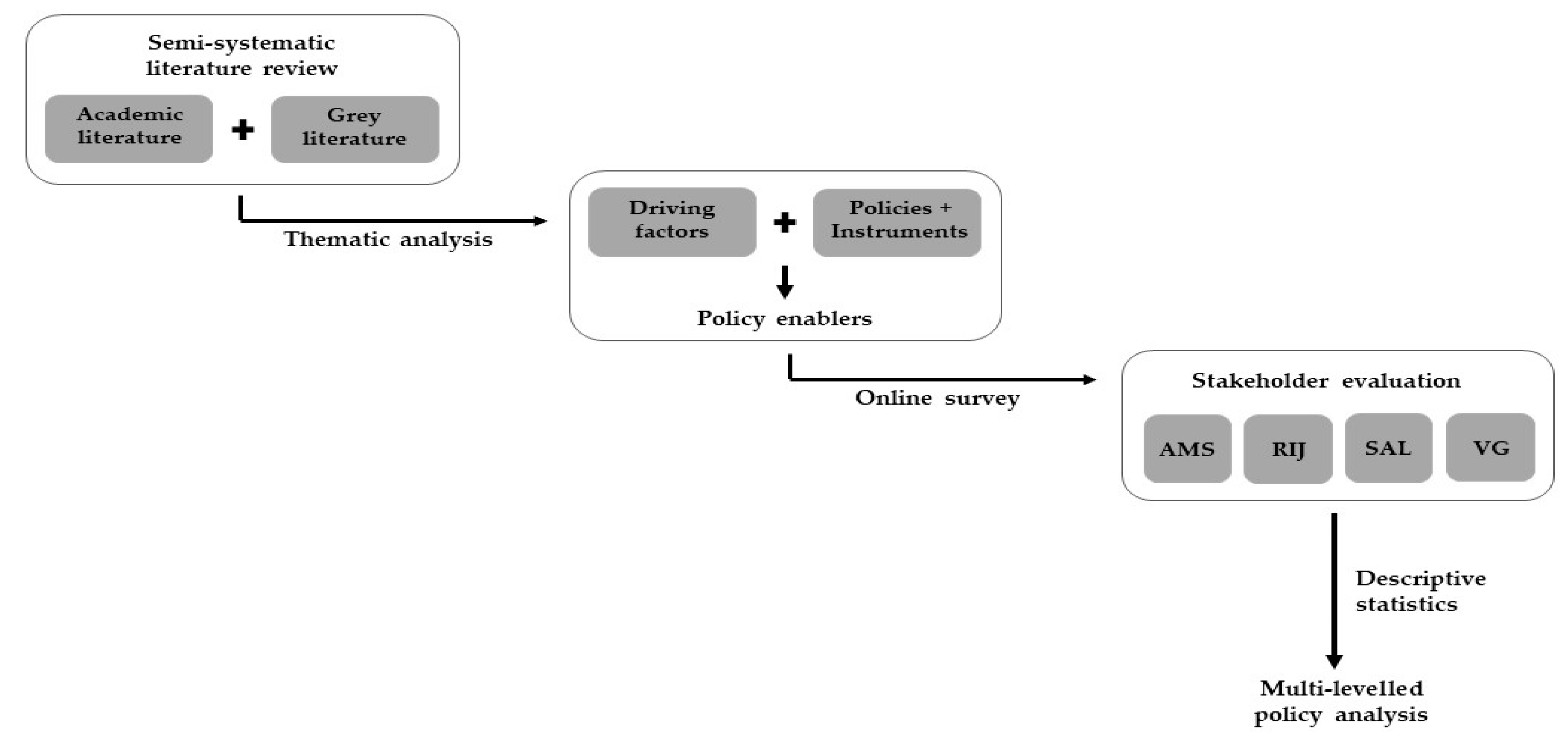
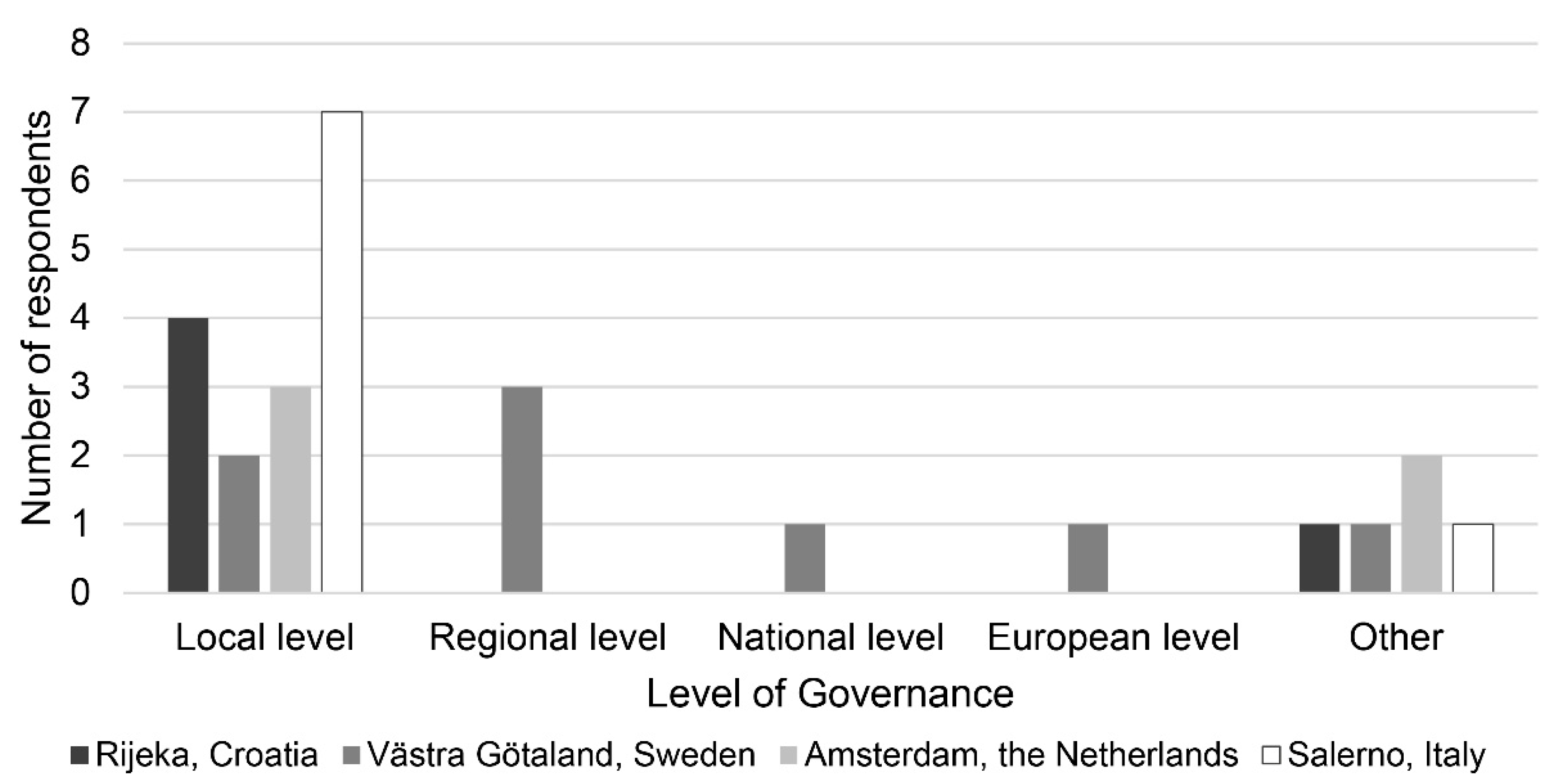
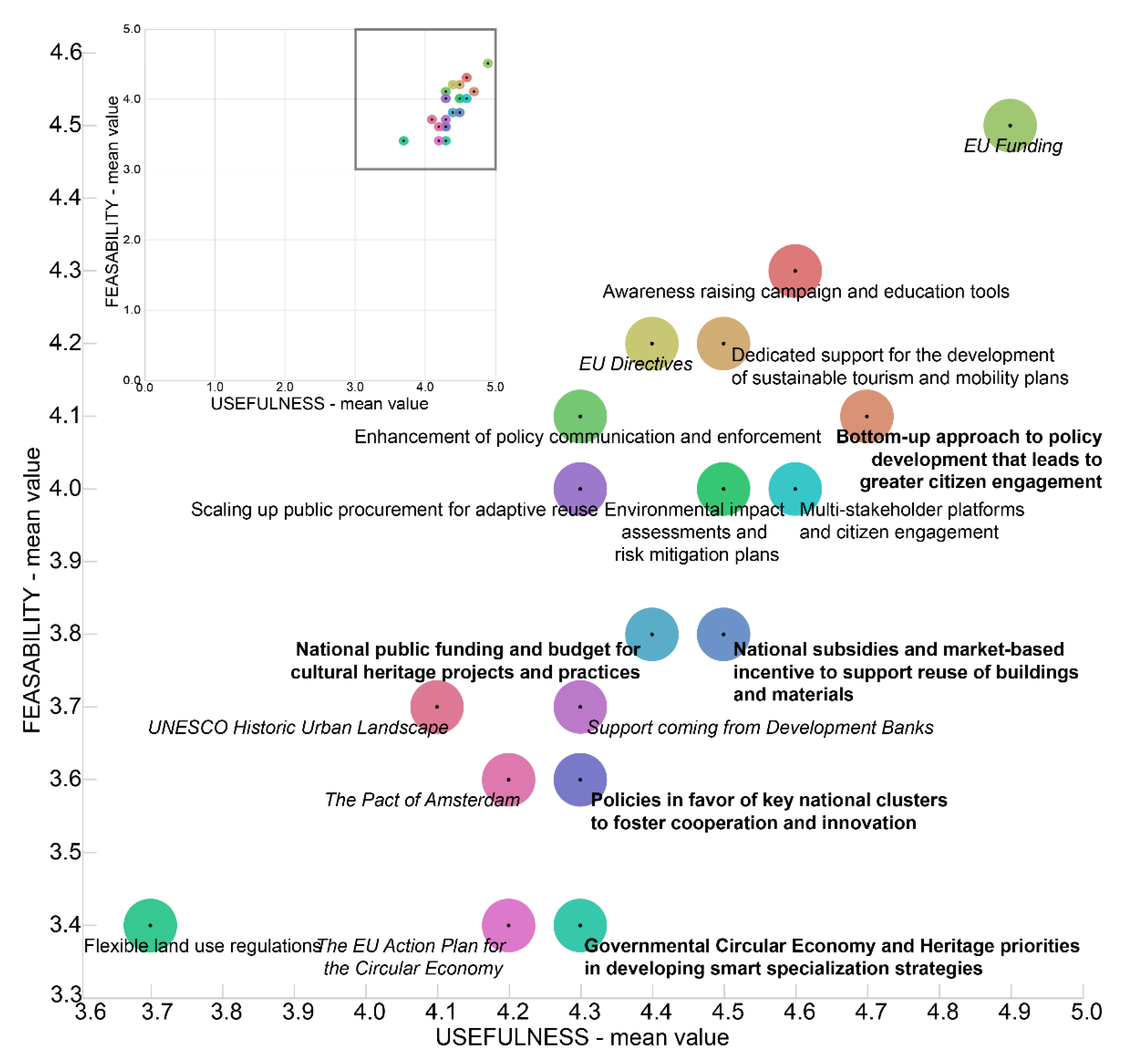
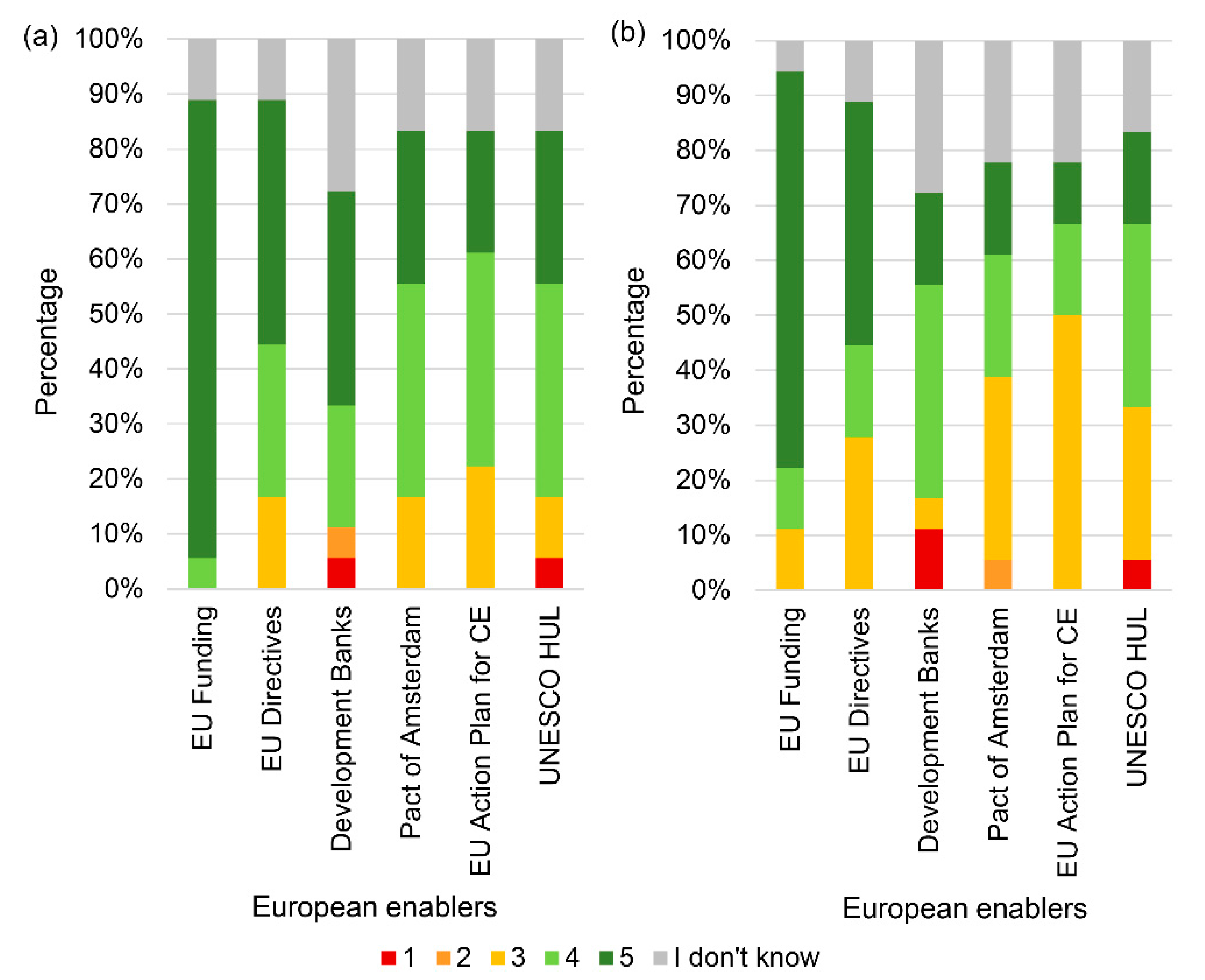
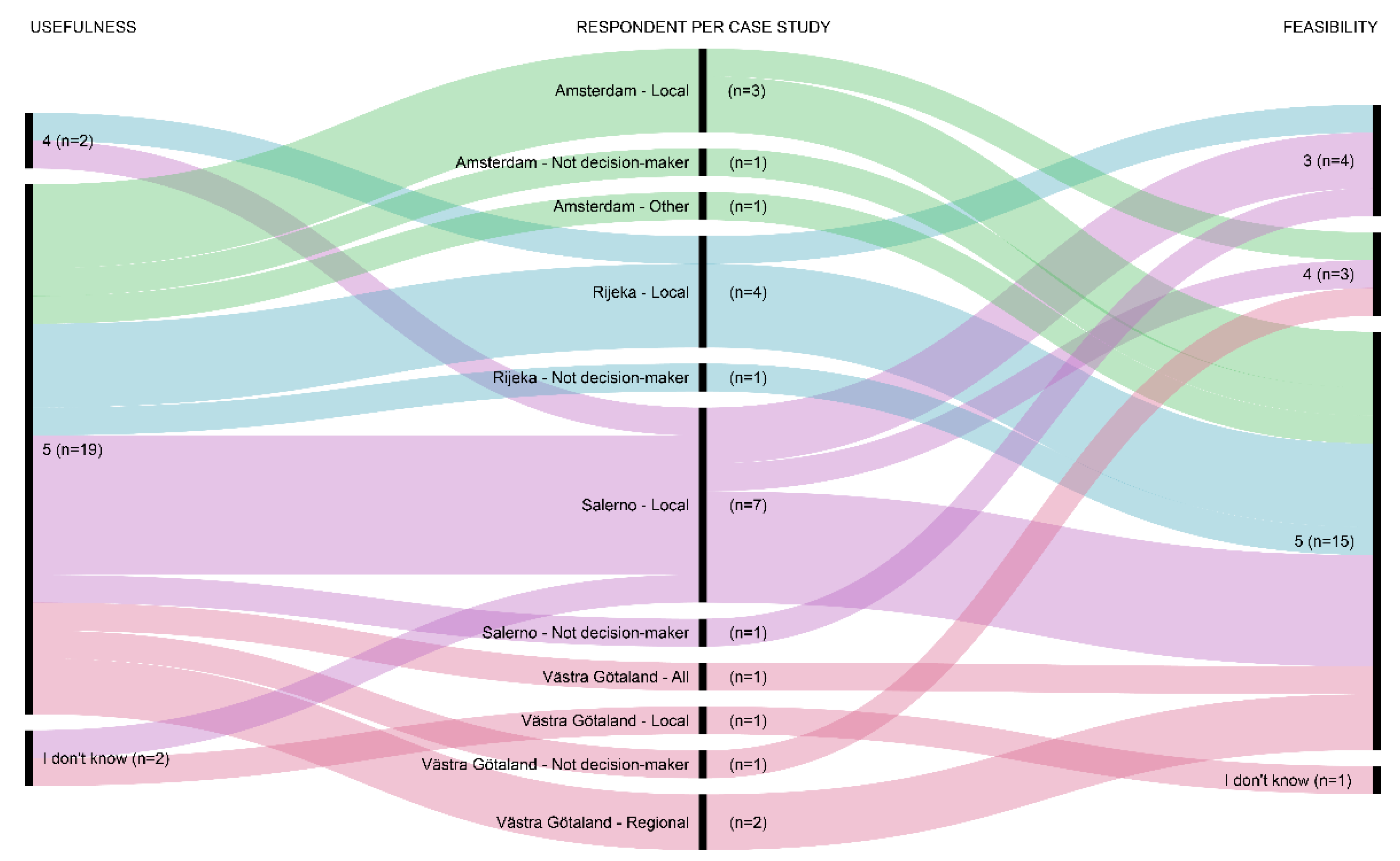

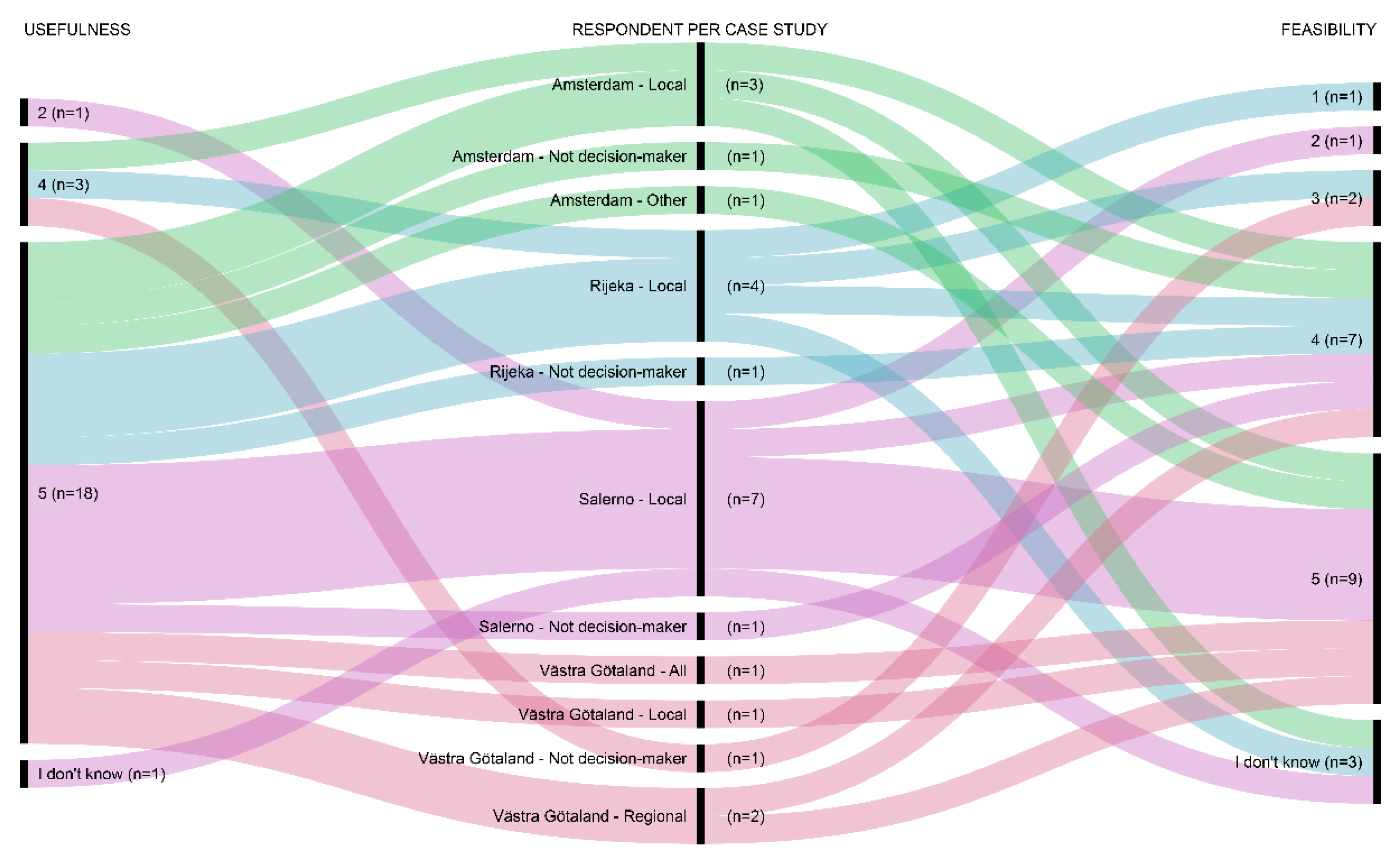
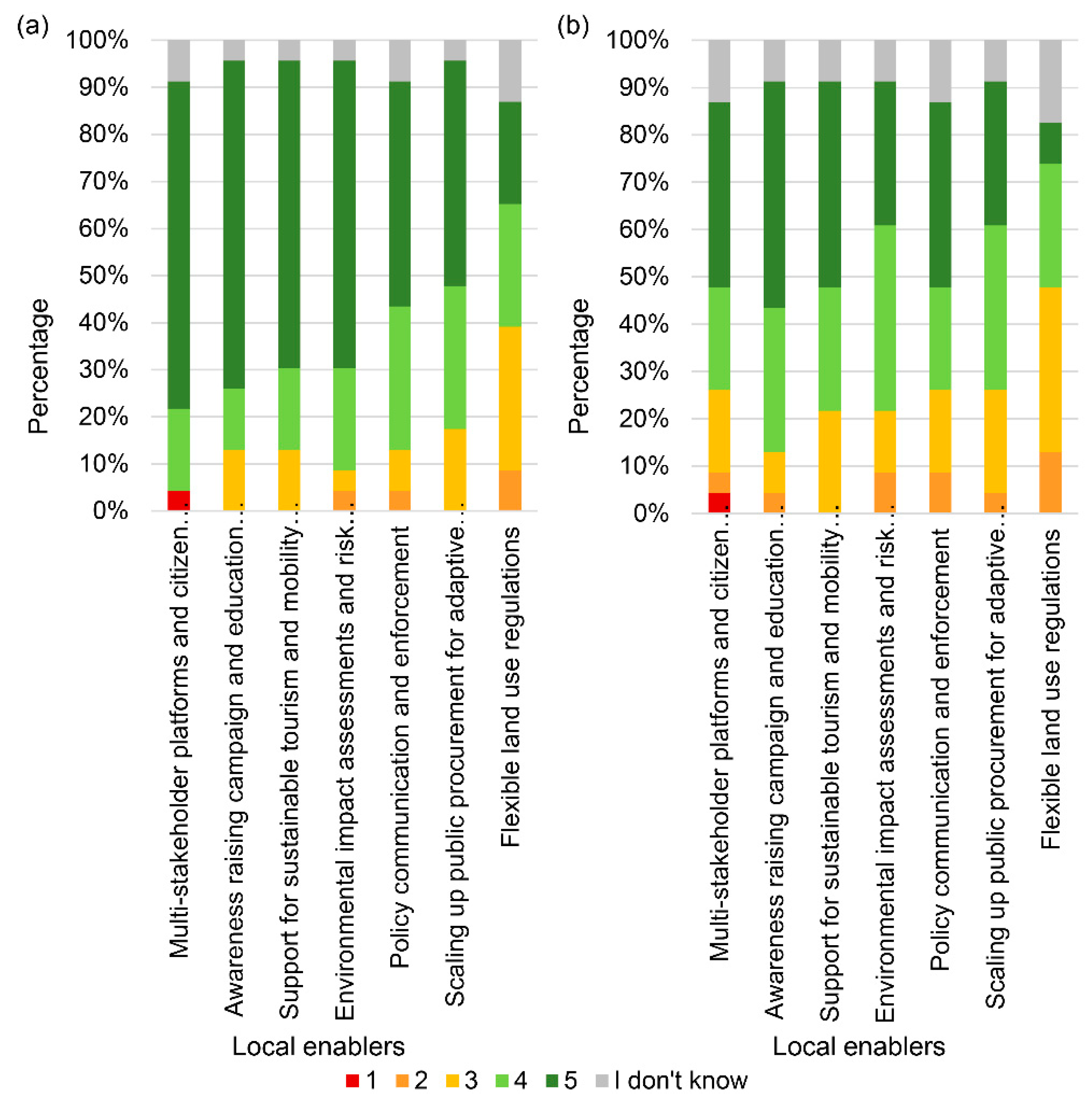

| Factor/Category | Keywords | Scope | Key References |
|---|---|---|---|
| Political | Government, authority, policy, democracy, transparency | It is concerned with governments, governmental policies and regulations that institutions have to comply with. It includes political policy and stability as well as national trade, fiscal and taxation policies. | [30,31] |
| Economic | Investment, funding, grants, loans, financial incentives, partnerships, economic activities | It is based upon the theoretical framework of urban and ecological economics. It involves the following themes: market forces, land use, urban transportation, public funding policies, housing, local government expenditures and taxes | [9,32] |
| Social | social equity, social inclusion, social cohesion, wellbeing, quality of life | It stands for the combination of social principles for basic societal needs, i.e., housing and health, equality and social justice with concepts associated with wellbeing, such as a sense of place, happiness and quality of life | [33,34,35,36] |
| Technical/technological | Sustainable buildings, building components and materials, design, techniques/methods, technology, innovation, tools, accessibility | It focuses on physical characteristics and technological aspects related to the built environment. It integrates both building and urban related factors, and encompasses a wide range of disciplines from design and engineering. | [1,37] |
| Environmental | Environment, climate change, natural hazards, energy efficiency, eco- friendly, green areas | Concerned with protecting the natural environment (particular ecosystems in and around properties), environmental factors involve gradual changes due to geological, climatic or other environmental factors, threats and protection from natural hazards, pollution, efficiency and improvement of natural resources, environmentally friendly interventions, etc. | [38] |
| Legal/legislative/regulatory | Legislation, legal acts, regulations, buildings codes, health and safety | It involves all legal-related topics and issues. Factors include zoning, land regulations, heritage legislation, building codes, local policies and strategies, health and safety regulations | [30] |
| Cultural | Cultural heritage, cultural values, intrinsic values, significance, sense of belonging, attractiveness | Set of cultural, spiritual, material, intellectual and emotional features of society or a social group, and that it encompasses, in addition to art and literature, lifestyles, ways of living together, value systems, traditions and beliefs | [39] |
| Administrative | Administration, governance, stakeholder engagement, citizen participation, collaboration | It is concerned with holding the balance between economic and social goals and between individual and communal goals. The aim is to align as nearly as possible the interests of individuals, of cultural heritage, and of society. governance and regulation of cultural expressions and cultural orientation systems | [40] |
| PESTEL-CA | Driving Factor | Context | Key References | Relevant Policy/Instrument |
|---|---|---|---|---|
| Political | Public administrative support | Existing governance structure; the role, duties and budget of public administration at different governance levels | [50] | Public procurement |
| Economic | Tourism | Increase in tourism flows, positive economic impact and local growth | [51,52,53,54] | Tourism development plan |
| Real-estate market | Changes in highest and best land use | [23,52,54] | Market-based incentives, public subsidies | |
| Financial aid | Subsidies/grants, equity investment, fiscal relief and/or loans | [55,56,57] | Public funding, subsidies, financial incentives | |
| Public financial return | Returns on public investments | [53,58] | EU directives | |
| Increasing construction costs | Setback for demolishment and new construction | [59] | ||
| Social | Affordable housing | Access to affordable housing after the reuse and regeneration implementation | [60,61] | European Social Fund, European Regional Development Fund; national subsidies |
| Social cohesion | Sense of community and belonging, collaboration, citizen engagement | [52,62] | Citizen engagement tools | |
| Well-being and quality of life | Public and urban health | [62,63,64] | Community improvement plan | |
| Technical/technological | Physical characteristics of buildings | Adaptability to a new function, flexibility for conversion, physical durability | [55,61,65,66,67] | Land use plan, building regulations |
| Sustainability and circularity goals | [18,62,67,68,69] | |||
| Environmental | Green and recreational spaces | Localization and number of green areas, public spaces, public parks, and recreational services | [50,62] | Land use plan, environmental impact assessment |
| Environment and natural capital | Protection of natural resources, creating and revitalization of green areas | [52] | Environmental impact assessment | |
| Reducing use of resources | [55,70] | Public procurement | ||
| Less energy consumption and material waste | [55,68,71] | Building regulations and codes, waste management policies | ||
| Legal/regulatory | Accessibility | Connection to public spaces, transportation nodes and hubs | [65] | Smart mobility plans and incentives |
| Cultural | Creative industries | Revitalization and creating spaces for creative and vibrant industries; creative, cultural and innovative activities | [52,53,60] | National grants and subsidies, cultural-focused land use |
| Cultural heritage value of property | Heritage significance and inherent values of heritage properties and landscapes | [52,53,72,73,74] | ||
| Administrative | Collaboration between multiple actors | Participatory governance, collaboration and consensus among multiple stakeholders and decision makers | [55] | Participatory governance models and tools |
| Participation and citizen engagement | Participatory decision-making, citizen deliberation and engagement | [75] | Citizen engagement tools |
| Scale | Policy Enabler | Description | Key References |
|---|---|---|---|
| European | |||
| EU Funding and Grants | The EU provides funding to support research and innovation on heritage-related projects through programmes such as Horizon2020 and Horizon Europe. the European Regional Development Fund, European Structural and Investment Funds and the Cohesion Fund also provide support in the transition towards circular economy, and to promote economic and social cohesion across Europe. | [84] | |
| EU Directives | Regulatory measures that support the Circular Economy agenda and the European Framework for Action on Cultural Heritage also act as facilitators for relevant actions to be adopted at local contexts. | [81,82] | |
| Support coming from Development Banks | As another European financial resource, European Investment Bank and the European Bank for Reconstruction and Development may also provide financial support. | [21] | |
| EU Action Plan for the Circular Economy | Adopted in 2015, this Action Plan aims to transform the economy of the EU and its Member States in favour of the circular economy. | [81] | |
| Pact of Amsterdam | In this EU Urban Agenda revised 2019, the role of social dimension and employment benefits of the adaptive reuse of cultural heritage are indicated. | [83] | |
| Historic Urban Landscape approach | Adopted by UNESCO in 2011, the HUL Recommendation provides an interdisciplinary and continually evolving toolkit to support conservation through transformation approach | [85] | |
| National | |||
| Bottom-up approach to policy development | In order to enhance greater citizen engagement in policy making and implementation, bottom-up approaches that engage local communities and social groups horizontally in the decision-making process is supported. | [55,75] | |
| National subsidies and market-based incentives | Public financial mechanisms and supplementary tools, such as subsidies, tax relief and other market-based incentives, leverage investments in adaptive reuse. | [53,54,55,56,57] | |
| National public funding and special budget | Public funding provided through grants, special budgetary allocations and loans also provide financial support. | [21,58] | |
| Policies in favour of key national clusters | To foster cooperation and innovation between public and private bodies, agglomeration of certain economic entities can be promoted to support collaboration for effective adaptive reuse practices. | [50,78] | |
| Governmental circular economy and heritage priorities for smart specialization | Lack of partnerships and prioritisation of circular economy and heritage-related strategies were addressed as challenges by local stakeholders. National smart specialization strategies aiming to support sustainability and circularity goals through adaptive reuse can be adopted through public–private and –people partnerships | [9,52,80] | |
| Local | |||
| Awareness raising campaign and education tools | Awareness raising campaigns focusing on action-based initiatives, coupled with educational tools are essential to raise awareness among different stakeholder groups on the impact of adaptive reuse in the transition to circularity. | [62,63] | |
| Multi-stakeholder platforms and citizen engagement | Establishing collaboration between governments, local administrators, private and public bodies, developers, local organizations and citizens are essential in reaching consensus to push local circularity agendas forward. | [52,62,75] | |
| Support for the development of sustainable tourism and mobility plans | Dedicated support from local administrative bodies for the development of sustainable tourism and mobility plans are important to enhance sustainable tourism development in the cities and regions. | [51,65] | |
| Environmental impact assessments and risk mitigation plans | With rising impact of climate change and other natural and human-induced threats, it is important to enforce the conduct of environmental impact assessment, and adoption of risk preparedness and mitigation plans at multiple levels. | [50,52] | |
| Scaling up public procurement for adaptive reuse | As public procurement decisions are predominantly based on economic concerns, often without considering the environmental costs, it is important to build and ensure a closer relationship between public procurement and circular economy agenda. | [55,70] | |
| Enhancement of policy communication and enforcement | Lack of communication between policy makers and stakeholders is an issue to be tackled with enhancement of policy communication for better implementation and promotion of reuse activities. | [50] | |
| Flexible land use regulations | Flexibility in land-use plans can facilitate culture- and tourism-led regeneration practices with temporary or permanent land use policies. | [60,61,75] | |
| Class | Range |
|---|---|
| Neutral | Mean = 3.00 |
| Slightly | 3.00 < Mean ≤ 3.66 |
| Moderately | 3.66 < Mean ≤ 4.33 |
| Very | 4.33 < Mean ≤ 5.00 |
| Lv | Enabler | Usefulness | Feasibility | ||||||||
|---|---|---|---|---|---|---|---|---|---|---|---|
| N 1 | Perc | Mean | SD | Cl | N 1 | Perc | Mean | SD | Cl 2 | ||
| European | |||||||||||
| EU Funding | 21 | 91% | 4.9 | 0.3 | V | 22 | 96% | 4.5 | 0.8 | V | |
| EU Directives | 21 | 91% | 4.4 | 0.7 | V | 20 | 87% | 4.2 | 1.0 | M | |
| Support coming from Development Banks | 18 | 78% | 4.3 | 1.1 | M | 18 | 78% | 3.7 | 1.3 | M | |
| The EU Action Plan for the Circular Economy | 19 | 83% | 4.1 | 1.0 | M | 19 | 83% | 3.7 | 0.9 | M | |
| The Pact of Amsterdam | 19 | 83% | 4.2 | 0.8 | M | 18 | 78% | 3.4 | 0.7 | S | |
| UNESCO Historic Urban Landscape | 18 | 78% | 4.2 | 0.7 | M | 17 | 74% | 3.6 | 0.9 | S | |
| National | |||||||||||
| Bottom-up approach to policy development that lead to greater citizen engagement | 22 | 96% | 4.7 | 0.7 | V | 20 | 87% | 4.1 | 1.1 | M | |
| National subsidies and market-based incentives to support reuse of buildings and materials | 21 | 91% | 4.5 | 0.8 | V | 20 | 87% | 3.8 | 1.2 | M | |
| National public funding and budget for cultural heritage projects and practices | 22 | 96% | 4.4 | 1.0 | V | 21 | 91% | 3.8 | 1.2 | M | |
| Policies in favor of key national clusters to foster cooperation and innovation | 20 | 87% | 4.3 | 0.9 | M | 19 | 83% | 3.6 | 1.0 | S | |
| Governmental circular economy and heritage priorities in developing smart specialization strategies | 18 | 78% | 4.3 | 0.9 | M | 17 | 74% | 3.4 | 0.9 | S | |
| Local | |||||||||||
| Awareness raising campaign and education tools | 22 | 96% | 4.6 | 0.7 | V | 21 | 91% | 4.3 | 0.9 | M | |
| Multi-stakeholder platforms and citizen engagement | 21 | 91% | 4.6 | 0.9 | V | 20 | 87% | 4.0 | 1.2 | M | |
| Dedicated support for the development of sustainable tourism and mobility plans | 22 | 96% | 4.5 | 0.7 | V | 21 | 91% | 4.2 | 0.8 | M | |
| Environmental impact assessments and risk mitigation plans | 22 | 96% | 4.5 | 0.8 | V | 21 | 91% | 4.0 | 0.9 | M | |
| Scaling up public procurement for adaptive reuse | 22 | 96% | 4.3 | 0.8 | M | 21 | 91% | 4.0 | 0.9 | M | |
| Enhancement of policy communication and enforcement | 21 | 91% | 4.3 | 0.9 | M | 20 | 87% | 4.1 | 1.1 | M | |
| Flexible land use regulations | 20 | 87% | 3.7 | 1.0 | M | 19 | 83% | 3.4 | 0.9 | S | |
Publisher’s Note: MDPI stays neutral with regard to jurisdictional claims in published maps and institutional affiliations. |
© 2021 by the authors. Licensee MDPI, Basel, Switzerland. This article is an open access article distributed under the terms and conditions of the Creative Commons Attribution (CC BY) license (http://creativecommons.org/licenses/by/4.0/).
Share and Cite
Ikiz Kaya, D.; Pintossi, N.; Dane, G. An Empirical Analysis of Driving Factors and Policy Enablers of Heritage Adaptive Reuse within the Circular Economy Framework. Sustainability 2021, 13, 2479. https://doi.org/10.3390/su13052479
Ikiz Kaya D, Pintossi N, Dane G. An Empirical Analysis of Driving Factors and Policy Enablers of Heritage Adaptive Reuse within the Circular Economy Framework. Sustainability. 2021; 13(5):2479. https://doi.org/10.3390/su13052479
Chicago/Turabian StyleIkiz Kaya, Deniz, Nadia Pintossi, and Gamze Dane. 2021. "An Empirical Analysis of Driving Factors and Policy Enablers of Heritage Adaptive Reuse within the Circular Economy Framework" Sustainability 13, no. 5: 2479. https://doi.org/10.3390/su13052479
APA StyleIkiz Kaya, D., Pintossi, N., & Dane, G. (2021). An Empirical Analysis of Driving Factors and Policy Enablers of Heritage Adaptive Reuse within the Circular Economy Framework. Sustainability, 13(5), 2479. https://doi.org/10.3390/su13052479







